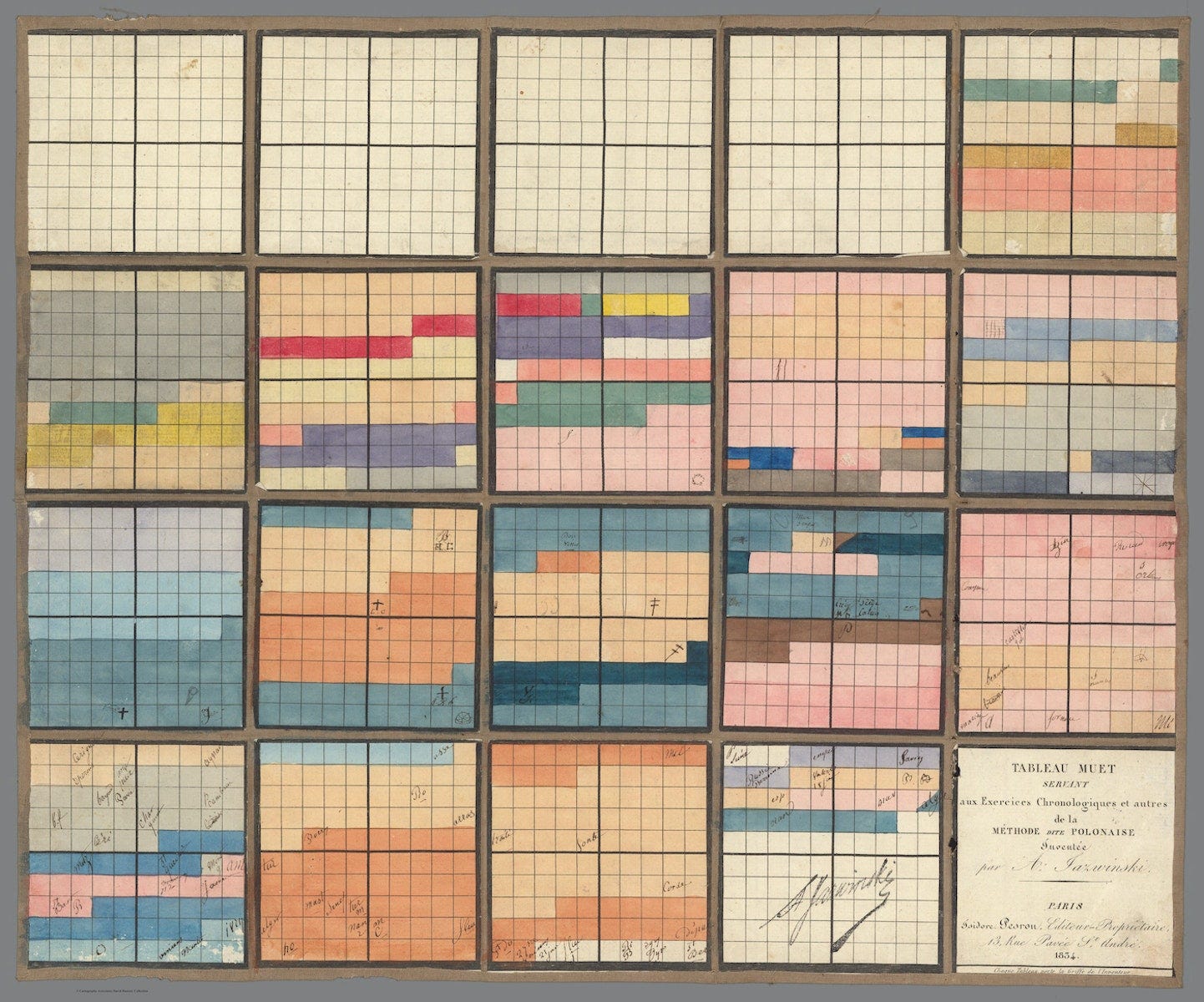No. 62 - Polish system ⫶ Territory Writing ⫶ Stories over time
Touch 262 years with your bare hands
My name is Linda. I write a bi-weekly newsletter about computer science, childhood, and culture - and there are 9 693 of you listening. If you enjoy this issue, please share it with anyone who may find it helpful.
The picture above is not a forgotten Mondrian or a spring garden plan. It's history in a graph. Looking at it, one can peer down thousands of years.
Invented in the 1820s by Polish Antoni Jażwiński and popularized by Józef Bem, the graph was a shorthand to remember history. The Polish System was intended for schoolkids to commit dates, events, and people to memory.
Each 10 x 10 box is a century, the rows separate a decade, and each square is a year. The colors and squares represent nations (with shading for monarchs or governments), dates, and characters. "The square indicates insubordination; a triangle would mean a revolt, an X a conspiracy," as the instructions explain.
The Polish System is such an interesting way to look at the mundane task of memorising history (something I think we still should do, however much computers help us) and showing causalities and connections. It also reminds me of Your Life in Weeks and Git commit history graphs, the tiny rectangles that fill with different colored squares every time a programmer works. The same kind of high-altitude look into life.
Another idea of Jażwiński's was that of "chronological constellations." Here, historical events marked in the grid form more prominent constellations — "sometimes it's a chair, a sickle, a boat, a letter of the alphabet, etc."
It's hard to see the broad sweep of history, as RJ Andrews stated. He uses ChatGPT to look at world history in 25-year blocks and surface ideas and narratives otherwise invisible. A generational lattice, he calls it, a helpful tool to structure his understanding and exploration of history.
Telling complex stories over time is something computers can hopefully help us with. These stories could also be highly personal.
I read On Time and Water by Andri Snaer Magnasson a few years ago. The book has a gorgeous little chapter called A Future Conversation. In the 2018 book, Magnasson asks his daughter to do some math.
Little Hulda Filippía, born in 2008, calculates the gap between her and her grandmother Hulda, born in 1924. She then calculates when she herself will be ninety-four years old. Then she figures out when her possible great-granddaughter will be ninety-four years old.
‘Yes, can you imagine that? You, born in 2008, might know a girl who will still be alive in the year 2186.’
How long is it from 1924 to 2186?’ Hulda does the maths. ‘Is it 262 years?’
‘Imagine that. Two hundred and sixty-two years. That’s the length of time you connect across. You’ll know the people who span this time. Your time is the time of the people you know and love, the time that moulds you. And your time is also the time of the people you will know and love. The time that you will shape. You can touch 262 years with your bare hands. Your grandma taught you, you will teach your great-granddaughter. You can have a direct impact on the future, right up to the year 2186.’
‘Up to 2186!’
One day in the future, a personalized Polish system, aided by whatever technology there is at the time, will help me explore my span of history of 260 years. The years I can touch with my bare hands.
Linked List
In computer science, a linked list is a linear collection of data elements whose order is not given by their physical placement in memory. But here it is a selection of things I’ve been reading lately.
Related to the last issue - it turns out flat origami is Turing complete.
Territory Writing. “Atlas of poetic writings tracing the relationship between humans and the territory on which they are established” describes an Instagram account with probably the highest frequency of words I care about!
Materiom. I’ve been growing bioplastic for a course; it’s wildly fun and makes me want to learn more about materials. The Materiom platform gathers examples from regenerative material solutions with a lofty mission, but learning about dragon fruit natural dye and avocado pits is also fun for its own sake.
Classroom
I’m hoping to surface and share stories from all of you and I’d love to see your creations! Here are a few teachers using Ruby in creative, fun and inspiring ways.
These drawings come from Bùi Lê Diễm in Vietnam, where they have been creating cool mindmaps around Ruby. I’ll have some news about the Vietnamese translations of the series early next year!
I love when educators make computers visible and allow children to use touch. Here Ms. Munoz and the second Ruby book.
The Italian Hello Ruby book with some wonderful underwater maps to explore. There’s also other guided activities online. And I hear the AI & Machine Learning book is coming soon out in Italian!








